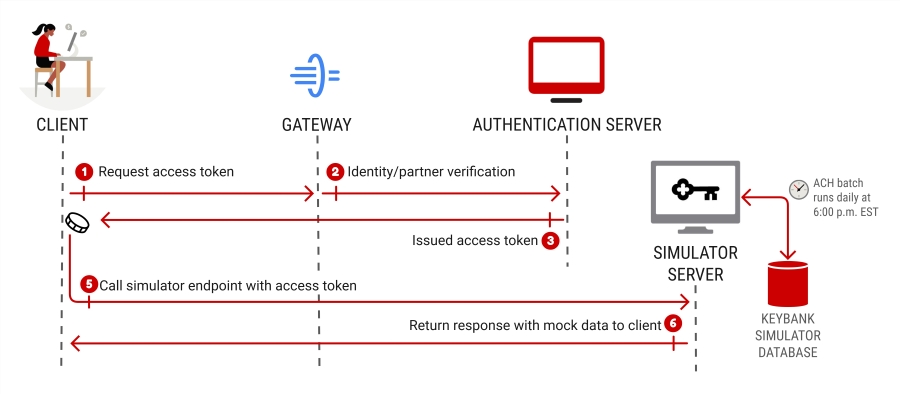Quick summary
The KeyBank API Simulator allows you to interact with a mock environment without affecting any live systems. It provides production-like setting where you can test APIs and experience how endpoints operate in real-world scenarios. While it is not an exact replica of a production environment, it closely mimics API data controls and transmission activity.
Benefits
- Make API requests without impacting real servers. Safely test functionality without affecting live systems.
- Test multiple scenarios and simulate varied responses. Experiment with successful calls, errors, and timeouts to valid behavior.
- View complete request and response data. Inspect the information exchanged during API interactions for better understanding.
- Customize requests for flexibility. Modify parameters, headers, and body content to explore different conditions and outcomes.
How it works
The simulator is data-driven on the information you provide. You send values in the request and verify the response returns the same information in key data points, like account number or name. Since it is data-driven, the more data you enter, the more scenarios you can test and analyze.

01
Authorization
Prepare your environment and ensure you have the necessary credentials. The KeyBank API Simulator requires its own set of API keys to prevent data contamination in other environments. You will receive a unique consumer_id and consumer_secret for the API simulator. You can continue to use the same client credentials (client_id and client_key).
When you are ready to make a call, have your access token and KeyBank credentials ready. Include your token in the Authorization header. (Learn how to get an access token.)
02
Download the simulator API specifications
Before you begin, download the latest version of the API specifications. The YAML file provides details on what the API does, how to make requests, what information to send, and what you'll receive in the response.
Download the simulator YAML file for one of these products:
03
Select an endpoint
Each API simulator includes the word "simulator” is its path. When you download the YAML file, make sure that the word 'simulator' is correctly placed in the endpoint path. or simply copy an endpoint from the table below.
You should have access to any simulator endpoints for any production API endpoints you are authorized to use. If not contact your Technical Account Manager for permission.
Note: For ACH simulator endpoints, data transmission goes to a simulated ACH batch that runs daily at 6:00 p.m. EST. After the batch runs, you can inquire about the status of an ACH transaction.
Simulator endpoints
| API | Simulator endpoint |
|---|---|
| Account Validation | /accounts/validations/v2/simulator/verifyAccount |
| Account Information | /commercial/accounts/simulator/v1/list /commercial/accounts/simulator/v1/{accountId} /commercial/accounts/simulator/v1/{accountId}/transactions/current /commercial/accounts/simulator/v1/{accountId}/transactions/previous |
| ACH Origination | /ach/payments/v1/simulator/status/addenda /ach/payments/v1/simulator/ccd /ach/payments/v1/simulator/ctx /ach/payments/v1/simulator/ppd /ach/payments/v1/simulator/tel /ach/payments/v1/simulator/web /ach/payments/v1/simulator/undo /ach/payments/v1/simulator/addenda |
| ACH Inquiry | /accounts/transactions/v1/ach/simulator/list /accounts/transactions/v1/ach/simulator/detail/{parNumber} |
| RTP Inquiry | /rtp/v1/transactions/simulator/list /rtp/v1/transactions/simulator/detail/{transactionId} |
| Wire Inquiry | /wireinquiry/v1/transactions/simulator/list /wireinquiry/v1/transactions/simulator/detail/{transactionId} |
04
Customize your request
In each request, you can modify details in the header and body. Start by coping the request body from the API document to get familiar with the API. Then, experiment with scenarios relevant to your use cases.
- Test different scenarios: Simulate success, failure, and edge cases (like testing with missing or incorrect data).
- Stay organized. Label and document your simulated API tests to keep track of different cases.
05
Review the response
Once you hit send, the simulator returns a response. The response data is intelligently generated to match the critical points across different endpoint requests. This enables realistic interactions and validation of API behavior.
- Responses include the standard HTTP status codes such as 200 (Success) or 404 (Not Found).
- Review the status codes and response body. If you get an error, check for typos in the endpoint, missing headers, or incorrect data in the body.
- Use the logs for debugging. Logs record all system interactions and help identify formatting issues or errors in your request.
 4-minute read
4-minute read  updated Dec. 09, 2025
updated Dec. 09, 2025